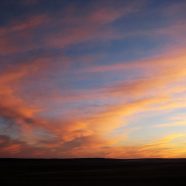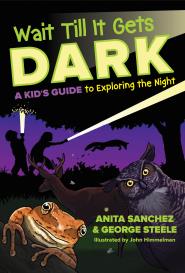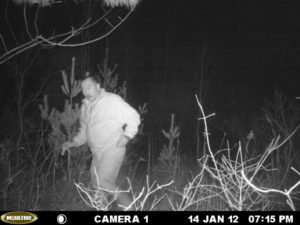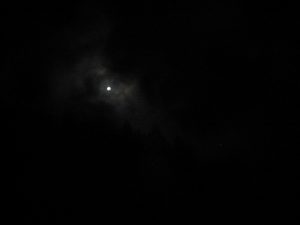
It’s night. It’s dark. It’s time to go indoors—or is it? The outdoors at night can be a scary place, but this book will help young readers investigate the mysterious nature of night.
To explore the night, it would be great to have eyes like an owl, the sensitive nose of a deer, and feet that can move as silently as a fox. Humans aren’t quite as good as nocturnal animals at navigating the darkness, but we can come surprisingly close. Our senses are much sharper than we realize, if we learn how to use them.
Each chapter of the book spotlights a different nocturnal creature. And while learning about animals’ adaptations for navigating the world of night, you’ll discover your own surprising abilities.
In Wait Till It Gets Dark, you’ll encounter:
–The great horned owl, who can spot the twitch of a mouse’s tail in almost total darkness.
–The Gila monster, who prowls the desert night using its tongue to locate prey.
–The super-sensitive ears of a bullfrog (yes, frogs have ears!)
–The delicate sense of touch of a spider, capturing its prey by feeling the slightest vibrations of its web.

An unidentified nocturnal mammal
Sidebars called “You Can Do It!” offer ways to explore your own senses—learning more about your eyes, ears, nose, and senses of touch and taste.
–While using crayons at night, can your eyes tell red from green?
–Can you hold completely still for an entire minute, like a fox stalking its prey?
–Could you follow the scent trail of an onion across the back yard?
–Can you find sounds in the dark? Learn to use the “big ears” technique to locate sounds with accuracy.
A Green-Eyed Glow
Ever see a dog’s eyes glow eerily green in a photograph? Other animals have this weird eyeshine at night, too. The eyeshine is caused by the reflected light from a thin sheet of tissue, called the tapetum lucidum, carpets the back of the animal’s retinas. Light goes into the eye, hits the rod cells, and then reflects off the tapetum lucidum like a sunbeam bouncing off a mirror. The light then hits the rod cells a second time on the way out. Night animals use light twice!
Who’s Out There in the Dark?
Foxes in your neighborhood—no way, right? But it’s very likely foxes are denning not far from where you are right now, even if you live in a city. Foxes live all over the United States—but they’re seldom seen.
Although foxes are in the same family as wolves and coyotes, they’re much smaller. A full-grown red fox weighs not much more than a large house cat. And they’re very good at hiding, even in little patches of brush and clumps of trees.
From the Book
Night. It’s scary out there. Time to go inside…or not?
There’s a dark and mysterious world waiting to be explored—and it’s just outside your door. By day, it’s as familiar to you as the back of your hand: the same old yard, street, and houses you see every day. But just wait till it gets dark!
What’s Going On Out There?
People usually get up in the morning, eat meals and do stuff during the day, and then sleep at night. But what if it was the other way around? Imagine waking up in the evening, having lunch at midnight, and climbing into bed as the sun rises. That’s what nocturnal animals do. Instead of sundown being the end of the fun, dusk is the time when everything begins.
For these creatures, night is the world they live in. Under the comforting cloak of darkness, they can hide from predators, hunt dinner, find mates. But when it’s pitch dark, how do they do what they have to do? How do they keep from bumping into trees, or falling off a cliff?

Beautiful illustrations by John Himmelman bring the night alive.
Nocturnal animals experience the world differently than we do. They can talk with their noses, taste smells in the air, and see light in different ways. They can smell scents and hear sounds that we can’t.
Humans have keen senses, too—we’re just not used to using them. Like playing the piano or learning to kick a soccer ball, sensing the night takes practice! We might not have eyes exactly like an owl’s, or a nose as sharp as a wolf’s, but humans can see, smell and hear in the dark much better than we realize.
So get ready to step into the darkness! Maybe it’s not that scary after all. You’ll challenge your senses to the max as you explore. Everything you see, hear, touch, smell, and even taste will be different than in daytime.
Because everything changes when the sun goes down…
It’s Night All Year Long!
Can you:
Find a fox footprint? Look in January snow for the oval tracks of these shy animals.
Hoot like an owl? Listen in wooded areas in February for the call of the great horned owl.
Hear pines sigh and branches rattle? Listen as the March wind blows the trees around.
Touch a pussy willow? In April, these soft buds are the first sign of spring.
Find a firefly? Look in May, in areas where tall grass grows, for these incredible insects.
Hear a bullfrog? In June, they shout “jug-o-rum!” in a deep voice.
Chase a moth? July flowers are often pollinated by night-flying moths.
Catch a falling star? Look in August for meteor showers and shooting stars.
star? Look in August for meteor showers and shooting stars.
Feel a dew drop? On chilly September evenings, feel the damp grass.
Taste a wild apple? In October, sour crabapples are ripe.
Listen to a coyote song? In November, listen for howls as coyotes signal to their families.
Taste a snowflake? In December, catch a falling flake on your tongue.





Recent Comments